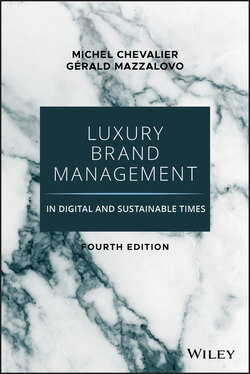Читать книгу Luxury Brand Management in Digital and Sustainable Times - Michel Chevalier - Страница 43
Limited Number of Staff
ОглавлениеThe fact that most luxury-goods companies are small or medium-sized enterprises has an obvious consequence: they also have a limited number of staff. In China, for example, the most successful luxury brands have staff numbers of only 100 to 1,000, most of them working in stores. The “small enterprise” element is also amplified by the fact that luxury brands must have a global presence. It is probably safe to say that there are more marketing executives in companies such as Procter & Gamble or Nestlé than in the total luxury-goods sector. Several elements contribute to this situation.
First, some companies are not just small; they can be very small. They may operate with just a small design studio that monitors trends and designs products, and may subcontract all the other activities to licensees and distributors. So, the next-most important area of activity after the studio is the legal department, or even an outside lawyer, which prepares and follows up contracts with outside partners. Some fashion companies have global headcounts that might not exceed 15 to 30 people. For example, the Nina Ricci brand has a design studio and a limited number of directly operated stores, while all its manufacturing and distribution are subcontracted.
This tendency to subcontract production activities is the second very particular aspect of the luxury field. Chanel doesn't have its own factories manufacturing all its ready-to-wear items or leather goods. Often, luxury-goods companies have just one or two factories, making prototypes and some product lines. The rest of the manufacturing is carefully controlled but is done by subcontractors. For example, the various components of most luxury-brand watches are generally produced by different companies before the final item is assembled in a fully owned workshop in Switzerland.
An automotive business is all about the factory, machinery, and equipment, but luxury brands are about design and communicating a message. Where are the products made? Who manufactures them? How many consumers know that companies in the LVMH Group, Bally, or Prada have some of their goods or, most probably, product components manufactured in China? What challenges does this pose at the production level? It seems that these questions are never raised.
Third, aside from the creative activity, the most important part of the luxury industry process is the sale. At Lancôme, probably 80% of the company's worldwide employees stand behind a counter. At Gucci, a very important part of the process happens in the stores. To make a career at Prada or Salvatore Ferragamo, it makes sense to start out working in a store—because this is where contact is made with the consumer. Very few of a luxury brand's employees will be based at headquarters, as all the investment goes into the stores. Ferragamo's group headquarters, Palazzo Feroni in Florence, also serves as the worldwide flagship store and a museum, an important tool for communicating with consumers.
So, the average luxury-goods company is small. Its sales figures include elements that are difficult to assess and to compare. A lot of activity at the level of manufacturing and distribution is subcontracted. And staff numbers are very limited.
